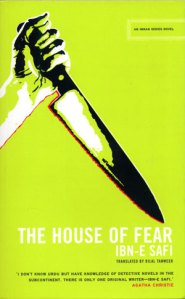Unless you can read Urdu, Ibn-e-Safi is probably the best-selling author you’ve never heard of—and certainly one of the most prolific. From 1948 until his death in 1980, Ibn-e-Safi wrote, quite literally, hundreds of books. Two of his series—Colonel Faridi and Ali Imran—had over 100 books each. At times, he wrote up to three or four novels a month, and then there’s still his satires and poetry to consider.
The latter character, Ali Imran, is introduced in The House of Fear. First published in 1955, it has, as of 2010, finally been translated into English. Imran is an absolute hoot—imagine a combination of Danny Kaye and Sherlock Holmes—intelligent, unstoppable and yet, to all outward appearances, an amiable fop.
He’s utterly brilliant, fond of mentioning his Oxford degrees. He’s supremely attractive and irresistible to women (well, as irresistible as he is annoying). And, perhaps most of all, he’s completely bonkers. His dialogue is a combination of pithy quotations (real and imaginary) and malapropisms, but somehow he always gets his point across. Similarly, he dresses like a circus sideshow and blunders around like an apparent idiot—only to always, ruthlessly and invariably, get his man.
As the first in the series, The House of Fear walks the fine balance between introducing an exceedingly memorable character and being a self-contained mystery in its own right. In the later books, Imran has been incorporated into Ibn-e-Safi’s ‘mythos’—serving as a secret agent for the unnamed South Asian country that is the recurring setting and even encountering characters from the other books. But for The House of Fear, it is all about Imran—we learn a bit about his background, a bit about his romantic entanglements (a spurned engagement!), a bit more about his family (government connections! A disappointed father!) and, of course, his methods (bizarre!).
The result is a character that threatens to dominate the book. Imran’s so eccentric that his misdirection works on two levels: both within the text and for the reader. But behind the smokescreen of lurid neckties and poetry snippets, there’s a detective with a steely mind, and, for all the humour and silliness, Imran is on the trail of a murderer. Whenever the goofiness is poised to overshadow the plot, Ibn-e-Safi brings it back with a reminder of the grim stakes. It takes an expert to juggle the perplexing demanour of the detective and the grisly reality of the crime, but, even in this early work, Ibn-e-Safi is up for the challenge.
The titular house, for the record, is abandoned—an empty house with an absentee owner. Yet, despite its nondescript nature, people keep turning up dead within its walls, stabbed to death with extremely distinctive wounds (always the same pattern… eerie). Imran’s interest is piqued, especially when he learns that documents of a (never-disclosed) political nature are involved.
Despite the novel’s brevity, Ibn-e-Safi showcases the full breadth of Imran’s talents. In one scene he’s sneaking like the proverbial high-level Thief/Acrobat. In another, he’s wooing (heartlessly) an old flame. In yet another he’s scrutinising small clues and drawing robust scientific conclusions in the best Sherlockian (or Encyclopedia Brownian) manner. There’s no challenge—physical, mental or emotional—that he can’t beat. With flair.
Needless to say, I found The House of Fear impossible not to love. Granted, the story of the book has a certain appeal. If you do invest in a copy, I highly recommend reading the introduction, as it describes (with unabashed adoration) an author that not only challenged a moribund literary status quo, but did so in an entertaining, warm and populist way—by essentially creating Urdu pulp: reading for everyone. He is quoted as saying:
Whatsoever the quality of fictional literature, it is eventually a means to mental escape. Its purpose is to provide recreation of one or the other level. Just as a football player cannot be entertained by a game of chess, similarly elitist or high literature is absolutely meaningless for a big segment of our society. Then why should I write for a few drawing rooms?
I think we bandy the term ‘escapism’ around a lot in genre fiction—often as a way of apologising for, or worse yet, ignoring, badly-written work. But Ibn-e-Safi reminds us that ’escapism’ also has inherent social value: a way of giving recreation and, as he later notes, a way of seeding “high concepts” to everyone. Literature in all forms is a mental retreat—why should that be a journey reserved exclusively for the elite?
But, beyond any greater political or literary significance, The House of Fear also has Imran, a truly unique detective that combines all the best intellectual rigour (praised by Agatha Christie!) with a wonderfully offbeat personality. The House of Fear isn’t just important, it is fun—and that might be Ibn-e-Safi’s greatest legacy.
Jared Shurin wants all the books.










